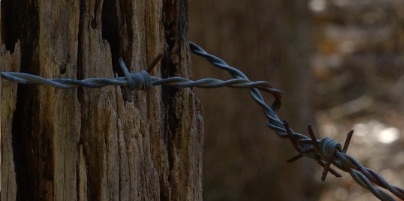 hat is the difference between liberals and conservatives? One answer is
that conservatives are the ones who can spell ‘ordnance’ right.
hat is the difference between liberals and conservatives? One answer is
that conservatives are the ones who can spell ‘ordnance’ right.
Sociologists and psychologists have tried to find their own answers to this question for decades. We've all seen what they come up with. Being academics, few have ever actually met a conservative. They only know the stereotypes, so their conclusions are often little more than ideologically based speculation.
Conservatives also ask the same question. One argument is that those guys on the left are just misguided and naive people who genuinely think wokeism is good and think they're really fighting racism and bigotry. They think the leftists just haven't figured out that their perceptions are wrong, but they're sure they must be true because it benefits their self-esteem to think so.

We are trapped behind barbed wire, and we'd be in chains if we could find a picture of a chain somewhere
This is the curse of politics: once a human decides which side they're on, all sources of information that support the decision become credible and all those that conflict with it become untrustworthy. Just as few conservatives will ever take anything the New York Times writes seriously, no left-winger will ever consider any evidence, no matter how compelling, from Breitbart that challenges their worldview.
Humans want, above all else, to avoid the need to question decisions they have made. And so they start by curating sources of information. Over time they come to see one side as natural and rational and the other as unhinged and divorced from reality.
A person's political views are derived from those things they believe to be true. A political person is driven mainly by fear, and fear is self-reinforcing. One way to counter fear is by bonding together in a group defined by the outsiders who are regarded as a physical threat. This group identity must be reinforced by selectively curated stories and morality tales, which further narrow their selection of sources of information. These narratives devolve into myths. If evidence for the myths cannot be found, it is manufactured, because the continued existence of the group depends on it.
The narratives that define group identity induce more fear. Each side reasons that if the fear is increasing, it means the guys on the other side must be getting even nastier than ever.
But how do we explain why liberals tend to riot, glue themselves to immobile objects, and smash windows, while conservatives don't? Why do liberals insist there is a climate crisis and conservatives insist that it's a hoax? Why would one side insist, contrary to irrefutable scientific evidence, that there are hundreds of different sexes?
Part of the answer is that group membership is reinforced by actions that harm the opposing group. Destroying their property and tearing down their statues are obvious ones. But inventing new sexes out of thin air and trying to force people to believe in their existence is another. They believe not that their opponents would ridicule them for being ignorant of biology, but that they would be upset and offended by the idea that gays, furries, and trans people are new sexes deserving of government recognition. Government involvement is key to making it a threat. Without it, it's not a threat but just another silly idea, like wearing those pink hats, and it quickly fades away. When their opponents rebel against being forced to believe something they know to be false, the activists take it as confirmation that they succeeded in harming their opponents. To the political mind, that is proof of one's righteousness.
(Furries, or should I say persons of furriness, have not been very successful at gaining government approval so far. At the moment we're still free to call it a paraphilia. But they're beavering away, and they know every dog has his day.)
Belief in a climate crisis that can only be solved by destroying Western economic power is derived from leftism, which is the political side of group identification. That this is true can be seen by the flat rejection of whatever solutions, like nuclear energy, the opponents propose. But people overlook that it is mainly a way of economically harming their political opponents. The idea seems to be that the enlightened class will be immune from the effects of abolishing fossil fuels. (This isn't true, of course; there seems to be a certain amount of wishful thinking going on there.)
The difference between liberals and conservatives can be most clearly seen in their opinion of former President Trump. Liberals hate Trump because he is supremely confident that they're in the wrong and because he's bombastic about it. Conservatives, at least most of them, admire Trump because of his accomplishments, and care little about his—or anybody else's—inflammatory tweeting.
Conclusion: Conservatives admire people for what they do. Liberals admire people for how they appear. Conservatives (and libertarians, let's not forget those guys) believe that individual rights supersede group rights, while liberals believe group rights are paramount.
jul 25 2022, 7:09 am
